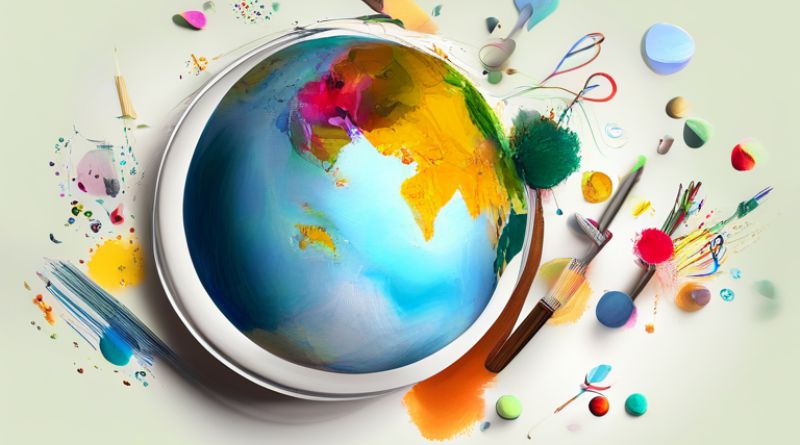Artistic design is an essential aspect of human expression, blending creativity, skill, and technique to create visual works that communicate ideas, emotions, and messages. From fine art to graphic design, this term encompasses a broad range of disciplines that shape the way we interact with the world visually. It is through artistic design that we experience the beauty and creativity of our surroundings, whether in paintings, digital media, architecture, or even in product packaging. This article explores the fundamental elements of artistic design, its history, significance, and impact on our lives.
Table of Contents
What is Artistic Design?
Artistic design refers to the process of creating visual compositions that are not only functional but also aesthetically pleasing. It involves the use of elements such as color, shape, texture, space, and typography to produce works that evoke feelings, express ideas, or convey a message. The purpose of artistic design can range from purely decorative to highly functional, as seen in everything from fashion to industrial design.
In its purest form, artistic design merges creativity with purpose. Whether it’s designing a logo, a product, or a piece of fine art, the goal is to communicate with the viewer in a meaningful way. Artistic design is not limited to any one medium but extends across various forms, including painting, sculpture, graphic design, fashion, and even web development.
The History of Artistic Design
The evolution of artistic design has been deeply influenced by historical, cultural, and technological shifts. From the early cave paintings of prehistoric humans to the intricate works of Renaissance masters, design has always been a reflection of human thought and ingenuity. The term “artistic design” as we know it today began to take shape in the 19th and 20th centuries with the advent of modernism and graphic design.
During the Renaissance, artists like Leonardo da Vinci and Michelangelo revolutionized the use of perspective, form, and space, laying the groundwork for future artistic movements. Fast forward to the Industrial Revolution, where the rise of mass production led to the development of design disciplines focused on utility and efficiency, such as product design and interior design. This period marked the birth of design schools like the Bauhaus in Germany, which promoted the combination of art and industry.
As technology advanced in the late 20th century, artistic design took on new forms through digital mediums. The creation of software tools like Adobe Photoshop and Illustrator revolutionized graphic design, enabling designers to create stunning visuals with precision and ease. Today, artistic design exists in a variety of fields, from advertising to digital art, and plays a critical role in shaping culture and communication.
Key Elements of Artistic Design
Several key elements define the success and impact of any artistic design. These components form the foundation of the design process, whether it’s a simple logo or an elaborate artwork. Understanding these elements is essential for both designers and art enthusiasts to appreciate the nuances of artistic design.
1. Line
Lines are the most fundamental element in artistic design. They can be straight, curved, or freeform, and they help to define shapes, create movement, and guide the viewer’s eye. Lines often evoke emotions; for example, jagged lines can suggest chaos or aggression, while smooth, flowing lines convey calmness and harmony.
2. Shape
Shapes are the building blocks of most designs. Whether geometric or organic, they provide structure and form to a design. In artistic design, the careful use of shapes helps create balance and visual interest. For example, circular shapes are often seen as soft and inviting, while sharp, angular shapes may feel more aggressive or edgy.
3. Color
Color plays a vital role in expressing emotion and setting the tone of a design. Each color has its own psychological impact, such as blue evoking calmness and trust, while red can elicit excitement or urgency. The combination of colors in artistic design can convey a wide range of meanings, from harmony to contrast.
4. Texture
Texture refers to the surface quality of an object, which can be visual or tactile. In two-dimensional design, texture can be simulated through patterns and shading, while in three-dimensional design, it is an actual physical characteristic. The texture of a design can make it feel more dynamic and engaging.
5. Space
Space refers to the area around and between elements in a design. The use of positive space (where elements are placed) and negative space (empty areas) is crucial for creating balance and readability. Effective use of space can make a design feel more organized and pleasing to the eye.
6. Typography
In graphic design, typography is the art of arranging typefaces. The choice of font, size, and spacing can significantly affect the overall aesthetic and tone of the design. Typography is not just about readability but also about enhancing the emotional impact of the message.
The Importance of Artistic Design in Modern Society
Artistic design has become more important than ever in today’s world. It influences nearly every aspect of our daily lives, from the products we buy to the advertisements we see. It shapes how businesses present themselves, how artists communicate their messages, and how we experience visual culture.
1. Branding and Marketing
One of the most significant roles of artistic design today is in branding and marketing. Companies rely heavily on visual design to communicate their identity, values, and products to consumers. Logos, packaging, advertisements, and websites are all designed to capture attention, build trust, and establish a memorable brand presence. A well-designed logo or marketing campaign can leave a lasting impression and drive business success.
2. Technology and Digital Media
The digital age has dramatically expanded the scope of artistic design. Graphic designers, web designers, and digital artists use innovative tools to create stunning visuals for websites, mobile apps, and social media platforms. In digital media, design is key to user experience (UX) and user interface (UI), ensuring that products are not only visually appealing but also easy and enjoyable to use.
3. Cultural Influence
Artistic design has the power to influence and reflect cultural trends. From fashion to street art, design has become a vehicle for cultural expression. Designers draw inspiration from various cultures, subcultures, and historical periods, creating works that resonate with diverse audiences.
The Future of Artistic Design
As technology continues to evolve, the future of artistic design looks promising. With advances in augmented reality (AR), virtual reality (VR), and artificial intelligence (AI), designers will have new tools at their disposal to push the boundaries of creativity. These innovations will lead to more immersive and interactive designs, transforming the way we experience art, advertising, and digital media.
Moreover, sustainability is becoming an important consideration in design, as more designers and companies focus on creating eco-friendly and socially responsible products. Artistic design in the future will likely emphasize ethical practices, incorporating sustainable materials and considering the environmental impact of design choices.
Frequently Asked Questions (FAQs)
1. What is the difference between artistic design and graphic design? Artistic design refers to the broader concept of creating aesthetically pleasing visuals, which can include fine art, product design, and architecture. Graphic design, on the other hand, is a specific discipline within artistic design focused on visual communication, primarily through digital and print media.
2. How can I improve my artistic design skills? Improving your artistic design skills requires practice, experimentation, and a strong understanding of design principles. Studying the work of other designers, taking courses, and learning design software can help you develop your abilities. It’s also essential to seek feedback and continually refine your work.
3. Can artistic design impact the way people feel? Yes, artistic design has the power to evoke emotions and influence perceptions. For instance, the colors, shapes, and composition of a design can make people feel calm, energized, or even anxious. This emotional response is often an intentional part of the design process.
4. What are some modern trends in artistic design? Some current trends in artistic design include minimalism, 3D design, and the use of bold, vibrant colors. Sustainable and eco-conscious design is also gaining momentum, with many designers prioritizing environmentally friendly materials and practices.
5. Why is artistic design important for businesses? For businesses, artistic design is essential in establishing a brand identity, attracting customers, and conveying a message. Well-designed logos, websites, and marketing materials help create a positive first impression and build trust with consumers.
Conclusion
Artistic design is a powerful tool for communication, creativity, and cultural expression. From its rich history to its current influence on business and technology, design shapes how we perceive the world around us. Whether in fine art, fashion, or digital media, artistic design continues to evolve, pushing boundaries and inspiring new generations of designers. As we move forward, the role of design will only grow in importance, influencing not just aesthetics but also functionality, sustainability, and emotional engagement in our everyday lives.






